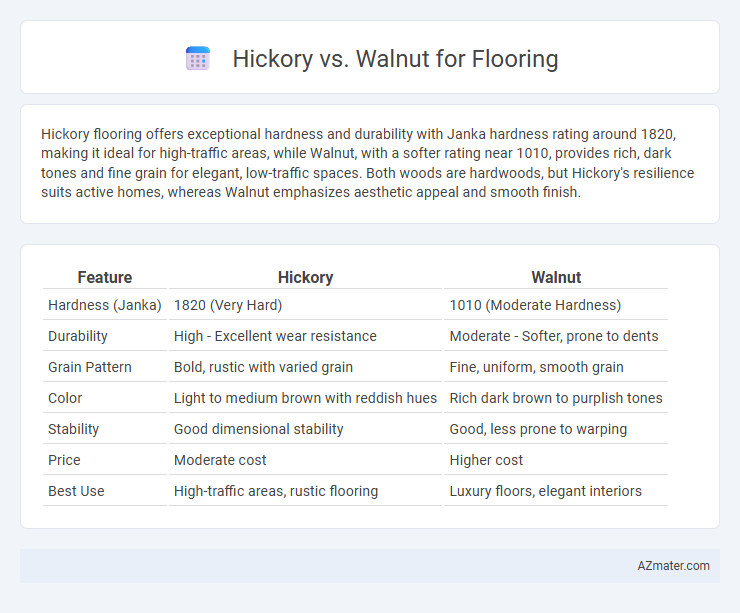Hickory flooring offers exceptional hardness and durability with Janka hardness rating around 1820, making it ideal for high-traffic areas, while Walnut, with a softer rating near 1010, provides rich, dark tones and fine grain for elegant, low-traffic spaces. Both woods are hardwoods, but Hickory's resilience suits active homes, whereas Walnut emphasizes aesthetic appeal and smooth finish.
Table of Comparison
| Feature | Hickory | Walnut |
|---|---|---|
| Hardness (Janka) | 1820 (Very Hard) | 1010 (Moderate Hardness) |
| Durability | High - Excellent wear resistance | Moderate - Softer, prone to dents |
| Grain Pattern | Bold, rustic with varied grain | Fine, uniform, smooth grain |
| Color | Light to medium brown with reddish hues | Rich dark brown to purplish tones |
| Stability | Good dimensional stability | Good, less prone to warping |
| Price | Moderate cost | Higher cost |
| Best Use | High-traffic areas, rustic flooring | Luxury floors, elegant interiors |
Introduction to Hickory and Walnut Flooring
Hickory flooring offers exceptional hardness and durability, making it ideal for high-traffic areas, while its distinctive grain patterns and color variations add rustic charm. Walnut flooring is prized for its rich, deep brown hues and smooth texture, providing a luxurious and elegant appearance with moderate hardness suitable for both traditional and modern interiors. Both hardwood options deliver long-lasting performance, but Hickory tends to be more resistant to wear, whereas Walnut emphasizes aesthetic appeal with its sophisticated, dark tones.
Origin and Characteristics of Hickory Wood
Hickory wood, native to the eastern United States, is known for its exceptional hardness and durability, making it ideal for high-traffic flooring. Its unique grain pattern features a combination of straight and wavy lines, with color variations ranging from pale beige to rich reddish brown. The natural shock resistance and density of hickory contribute to a resilient and long-lasting floor surface compared to walnut.
Unique Features of Walnut Flooring
Walnut flooring offers a rich, deep chocolate-brown hue with striking grain patterns that create a sophisticated visual appeal unmatched by other hardwoods like hickory. Its natural resistance to warping and fewer knots contribute to a smoother, more refined surface, ideal for high-end interiors. Walnut's subtle density provides a perfect balance between durability and softness, making it comfortable underfoot while maintaining long-lasting wear.
Durability and Hardness Comparison
Hickory offers superior hardness with a Janka rating of approximately 1820, making it one of the hardest domestic hardwoods ideal for high-traffic flooring areas. Walnut, with a softer Janka rating around 1010, provides a more forgiving surface but is less resistant to dents and scratches compared to hickory. For durability-focused flooring, hickory's dense grain and toughness outperform walnut, which requires more maintenance to retain its appearance in demanding environments.
Color, Grain, and Aesthetic Differences
Hickory flooring showcases strong color variations ranging from creamy white to rich amber, offering a dynamic and rustic aesthetic complemented by its pronounced, irregular grain patterns. Walnut floors feature a deep, rich chocolate brown hue with occasional purplish undertones, paired with a smoother, straight grain that exudes elegance and sophistication. The contrasting tonal range and grain intricacy between hickory and walnut create distinctly different visual impacts, making hickory ideal for rustic or country-style interiors and walnut suited for formal, contemporary spaces.
Maintenance and Cleaning Needs
Hickory floors require more frequent cleaning due to their softer nature, which makes them more susceptible to dents and scratches, necessitating gentle sweeping and occasional use of a hardwood floor cleaner to maintain their appearance. Walnut floors, being harder and denser, demand less maintenance and are more resistant to wear, allowing for less frequent cleaning with mild soap solutions and occasional polishing to preserve their rich color and grain. Both woods benefit from prompt spill cleanup and regular dusting to prevent damage and extend floor longevity.
Installation Considerations
Hickory flooring requires careful acclimation due to its high hardness and moisture sensitivity, ensuring optimal expansion and contraction tolerance during installation. Walnut floors demand precise subfloor preparation to prevent denting, with installers often preferring nail-down or floating methods to maintain wood integrity. Both species benefit from professional installation to address their unique density and grain patterns, which influence adhesive bonding and fastener choice.
Cost Comparison: Hickory vs Walnut
Hickory flooring generally costs between $6 and $9 per square foot, making it a more budget-friendly option compared to walnut, which ranges from $8 to $12 per square foot. The price difference reflects walnut's premium appeal due to its rich color and fine grain, while hickory offers high durability and distinctive grain patterns at a lower price point. Homeowners seeking cost efficiency often choose hickory for flooring, whereas walnut is preferred for upscale projects that justify its higher investment.
Best Applications for Each Wood Type
Hickory offers exceptional hardness and shock resistance, making it ideal for high-traffic areas like hallways and kitchens, where durability is paramount. Walnut provides a rich, dark aesthetic with a smooth grain, best suited for formal living rooms and bedrooms that emphasize elegance and warmth. Choosing between hickory and walnut depends on balancing functional durability with desired interior style.
Which Flooring Should You Choose?
Hickory flooring offers exceptional durability and a distinctive grain pattern, making it ideal for high-traffic areas and rustic interior designs. Walnut flooring provides a rich, dark color with smooth texture, adding elegance and warmth to any space, though it is softer and more prone to dents compared to hickory. Choosing between hickory and walnut depends on your preference for hardness and appearance, with hickory best suited for durability and walnut preferred for aesthetic appeal.

Infographic: Hickory vs Walnut for Floor
 azmater.com
azmater.com